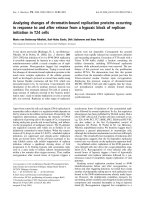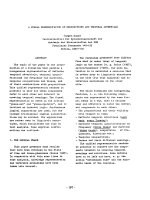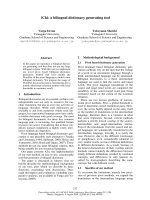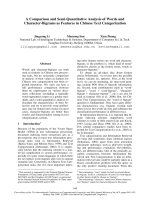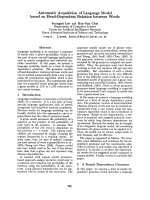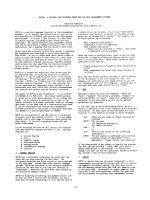Báo cáo khoa học: "A Latent Topic Extracting Method based on Events in a Document and its Application" pot
Bạn đang xem bản rút gọn của tài liệu. Xem và tải ngay bản đầy đủ của tài liệu tại đây (262.03 KB, 6 trang )
Proceedings of the ACL-HLT 2011 Student Session, pages 30–35,
Portland, OR, USA 19-24 June 2011.
c
2011 Association for Computational Linguistics
A Latent Topic Extracting Method based on Events in a Document
and its Application
Risa Kitajima
Ochanomizu University
Ichiro Kobayashi
Ochanomizu University
Abstract
Recently, several latent topicanalysis methods
such as LSI, pLSI, and LDA have been widely
used for text analysis. However, those meth-
ods basicallyassign topics to words, but do not
account for the events in a document. With
this background, in this paper, we propose a
latent topic extracting method which assigns
topics to events. We also show that our pro-
posed method is useful togenerate a document
summary based on a latent topic.
1 Introduction
Recently, several latent topic analysis methods such
as Latent Semantic Indexing (LSI) (Deerwester
et al., 1990), Probabilistic LSI (pLSI) (Hofmann,
1999), and Latent Dirichlet Allocation (LDA) (Blei
et al., 2003) have been widely used for text analy-
sis. However, those methods basically assign top-
ics to words, but do not account for the events in a
document. Here, we define a unit of informing the
content of document at the level of sentence as an
“Event”
1
, and propose a model that treats a docu-
ment as a set of Events. We use LDA as a latent
topic analysis method, and assign topics to Events
in a document. To examine our proposed method’s
performance on extracting latent topics from a doc-
ument, we compare the accuracy of our method to
that of the conventional methods through a common
document retrieval task. Furthermore, as an appli-
cation of our method, we apply it to a query-biased
document summarization (Tombros and Sanderson,
1
For the definition of an Event, see Section 3.
1998; Okumura and Mochizuki, 2000; Berger and
Mittal, 2000) to verify that the method is useful for
various applications.
2 Related Studies
Suzuki et al. (2010) proposed a flexible latent top-
ics inference in which topics are assigned to phrases
in a document. Matsumoto et al. (2005) showed
that the accuracy of document classification will be
improved by introducing a feature dealing with the
dependency relationships among words.
In case of assigning topics to words, it is likely
that two documents, which have the same word fre-
quency in themselves, tend to be estimated as they
have the same topic probablistic distribution without
considering the dependency relation among words.
However, there are many cases where the relation-
ship among words is regarded as more important
rather than the frequency of words as the feature
identifying the topics of a document. For example,
in case of classifying opinions to objects in a doc-
ument, we have to identify what sort of opinion is
assigned to the target objects, therefore, we have to
focus on the relationship among words in a sentence,
not only on the frequent words appeared in a docu-
ment. For this reason, we propose a method to as-
sign topics to Events instead of words.
As for studies on document summarization, there
are various methods, such as the method based on
word frequency (Luhn, 1958; Nenkova and Van-
derwende, 2005), and the method based on a graph
(Radev, 2004; Wan and Yang, 2006). Moreover,
several methods using a latent topic model have
been proposed (Bing et al., 2005; Arora and Ravin-
30
dran, 2008; Bhandari et al., 2008; Henning, 2009;
Haghighi and Vanderwende, 2009). In those stud-
ies, the methods estimate a topic distribution on each
sentence in the same way as the latent semantic anal-
ysis methods normally do that on each document,
and generate a summary based on the distribution.
We also show that our proposed method is useful for
the document summarization based on extracting la-
tent topics from sentences.
3 Topic Extraction based on Events
In this study, since we deal with a document as a
set of Events, we extract Events from each docu-
ment; define some of the extracted Events as the in-
dex terms for the whole objective documents; and
then make an Event-by-document matrix consisting
of the frequency of Events to the documents. A la-
tent topic distribution is estimated based on this ma-
trix.
3.1 Definition of an Event
In this study, we define a pair of words in depen-
dent relation which meets the following conditions:
(Subject, Predicate) or (Predicate1, Predicate2) , as
an Event. A noun and unknown words correspond
to Subject, while a verb, adjective and adjective
verb correspond to Predicate. To extract these pairs,
we analyze the dependency structure of sentences
in a document by a Japanese dependency structure
analyzer, CaboCha
2
. The reason why we define
(Predicete1, Predicate2) as an Event is because we
recognized the necessity of such type of an Event by
investigating the extracted pairs of words and com-
paring them with the content of the target document
in preliminary experiments, and could not extract
any Event in case of extracting an Event from the
sentences without subject.
3.2 Making an Event-by-Document Matrix
In making a word-by-document matrix, high-
frequent words appeared in any documents, and ex-
tremely infrequent words are usually not included in
the matrix. In our method, high-frequent Events like
the former case were not observed in preliminary ex-
periments. We think the reason for this is because an
Event, a pair of words, can be more meaningful than
2
taku/software/cabocha/
a single word, therefore, an Event is particularly a
good feature to express the meaning of a document.
Meanwhile, the average number of Events per sen-
tence is 4.90, while the average number of words per
sentence is 8.93. A lot of infrequent Events were ob-
served in the experiments because of the nature of an
Event, i.e., a pair of words. This means that the same
process of making a word-by-document matrix can-
not be applied to making an Event-by-document ma-
trix because the nature of an Event as a feature ex-
pressing a document is different from that of a word.
In concrete, if the events, which once appear in doc-
uments, would be removed from the candidates to
be a part of a document vector, there might be a case
where the constructed document vector does not re-
flect the content of the original documents. Consid-
ering this, in order to make the constructed docu-
ment vector reflect the content of the original doc-
uments, we do not remove the Event only itself ex-
tracted from a sentence, even though it appears only
once in a document.
3.3 Estimating a Topic Distribution
After making an Event-by-document matrix, a la-
tent topic distribution of each Event is estimated by
means of Latent Dirichlet Allocation. Latent Dirich-
let Allocation isa generative probabilistic modelthat
allows multiple topics to occur in a document, and
gets the topic distribution based on the idea that
each topic emerges in a document based on a certain
probability. Each topic is expressed as a multinomial
distribution of words.
In this study, since a topic is assigned to an Event,
each topic is expressed as a multinomial distribution
of Events. As a method to estimate a topic distri-
bution, while a variational Bayes method (Blei et
al., 2003) and its application (Teh et al., 2006) have
been proposed, in this study we use Gibbs sampling
method (Grififths and Steyvers, 2004). Furthermore,
we define a sum of topic distributions of the events
in a query as the topic distribution of the query.
4 Performance Evaluation Experiment
Through a common document retrieval task, we
compare our method with the conventional method
and evaluate both of them. In concrete, we regard
the documents which have a similar topic distribu-
31
tion to a query’s topic distribution as the result of
retrieval, and then examine whether or not the esti-
mated topic distribution can represent the latent se-
mantics of each document based on the accuracy of
retrieval results. Henceforth, we call the conven-
tional word-based LDA “wordLDA” and our pro-
posed event-based LDA “eventLDA”.
4.1 Measures for Topic Distribution
As measures for identifying the similarity of
topic distribution, we adopt Kullback-Leibler Di-
vergence (Kullback and Leibler, 1951), Symmetric
Kullback-Leibler Divergence (Kullback and Leibler,
1951), Jensen-Shannon Divergence (Lin, 2002), and
cosine similarity. As for wordLDA, Henning (2009)
has reported that Jensen-Shannon Divergence shows
the best performance among the above measures in
terms of estimating the similarity between two sen-
tences. We also compare the performance of the
above measures when using eventLDA.
4.2 Experimental Settings
As for the documents used in the experiment, we use
a set of data including users’ reviews and their eval-
uations for hotels and their facilities, provided by
Rakuten Travel
3
. Each review has five-grade eval-
uations of a hotel’s facilities such as room, location,
and so on. Since the data hold the relationships be-
tween objects and their evaluations, therefore, it is
said that they are appropriate for the performance
evaluation of our method because the relationship is
usually expressed in a pair of words, i.e., an Event.
The query we used in the experiment was “a room is
good”. The total number of documents is 2000, con-
sisting of 1000 documents randomly selected from
the users’ reviews whose evaluation for “a room” is
1 (bad) and 1000 documents randomly selected from
the reviews whose evaluation is 5 (good). The latter
1000 documents are regarded as the objective doc-
uments in retrieval. Because of this experiment de-
sign, it is clear that the random choice for retrieving
“good” vs. “bad” is 50%. As for the evaluation mea-
sure, we adopt 11-point interpolated average preci-
sion.
In this experiment, a comparison between the
both methods, i.e., wordLDA and eventLDA, is con-
3
/>ducted from the viewpoints of the proper number
of topics and the most useful measure to estimate
similarity. At first, we use Jensen-Shannon Diver-
gence as the measure to estimate the similarity of
topic distribution, changing the number of topics k
in the following, k = 5, k = 10, k = 20, k = 50,
k = 100, and k = 200. Next, the number of topics
is fixed based on the result of the first process, and
then it is decided which measure is the most useful
by applying each measure to estimate the similarity
of topic distributions. Here, the iteration count of
Gibbs Sampling is 200. The number of trials is 20,
and all trials are averaged. The same experiment is
conducted for wordLDA to compare both results.
4.3 Result
Table 1 shows the retrieval result examined by 11-
point interpolated average precision, changing the
number of topicsk. High accuracy is shown atk = 5
in eventLDA, and k = 50 in wordLDA, respectively.
Overall, we see that eventLDA keeps higher accu-
racy than wordLDA.
number of topics wordLDA eventLDA
5 0.5152 0.6256
10 0.5473 0.5744
20 0.5649 0.5874
50 0.5767 0.5740
100 0.5474 0.5783
200 0.5392 0.5870
Table 1: Result based on the number of topics.
Table 2 shows the retrieval result examined by
11-point interpolated average precision under vari-
ous measures. The number of topics k is k = 50
in wordLDA and k = 5 in eventLDA respectively,
based on the above result. Under any measures,
we see that eventLDA keeps higher accuracy than
wordLDA.
similarity measure wordLDA eventLDA
Kullback-Leibler 0.5009 0.5056
Symmetric Kullback-Leibler 0.5695 0.6762
Jensen-Shannon 0.5753 0.6754
cosine 0.5684 0.6859
Table 2: Performance under various measures.
4.4 Discussions
The result of the experiment shows that eventLDA
provides a better performance than wordLDA, there-
32
fore, we see our method can properly treat the latent
topics of a document. In addition, as for a prop-
erty of eventLDA, we see that it can provide detail
classification with a small number of topics. As the
reason for this, we think that a topic distribution on
a feature is narrowed down to some extent by using
an Event as the feature instead of a word, and then
as a result, the possibility of generating error topics
decreased.
On the other hand, a proper measure for our
method is identified as cosine similarity, although
cosine similarity is not a measure to estimate prob-
abilistic distribution. It is unexpected that the mea-
sures proper toestimate probabilistic distribution got
the result of lower performance than cosine similar-
ity. From this, there are some space where we need
to examine the characteristics of topic distribution as
a probabilistic distribution.
5 Application to Summarization
Here, we show multi-document summarization as
an application of our proposed method. We make
a query-biased summary, and show the effectiveness
of our method by comparing the accuracy of a gener-
ated summary by our method with that of summaries
by the representative summarization methods often
used as benchmark methods to compare.
5.1 Extracting Sentences by MMR-MD
In extracting important sentences, considering only
similarity to a given query, we may generate a redun-
dant summary. To avoid this problem, a measure,
MMR-MD (Maximal Marginal Relevance Multi-
Document), was proposed (Goldstein et al., 2000).
This measure is the one which prevents extracting
similar sentences by providing penalty score that
corresponds to similarity between a newly extracted
sentence and the previously extracted sentences. It
is defined by Eq. 1 (Okumura and Nanba, 2005).
MMR-MD ≡ argmax
C
i
∈R\S
[λSim
1
(C
i
,Q)
−(1−λ)max
C
j
∈S
Sim
2
(C
i
,C
j
)] (1)
We aim to choose sentences whose content is sim-
ilar to query’s content based on a latent topic, while
reducing the redundancy of choosing similar sen-
tences to the previously chosen sentences. There-
fore, we adopt the similarity of topic distributions
C
i
: sentence in the document sets
Q : query
R : a set of sentences retrieved by Q from the document sets
S : a set of sentences in R already extracted
λ : weighting parameter
for Sim
1
which estimates similarity between a sen-
tence and a query, and adopt cosine similarity based
on Events as a feature unit for Sim
2
which estimates
the similarity with the sentences previously chosen.
As the measures to estimate topic distribution simi-
larity, we use the four measures explained in Section
4.1. Here, as for the weighting parameter λ, we set
λ = 0.5.
5.2 Experimental Settings
In the experiment, we use a data set provided at NT-
CIR4 (NII Test Collection for IR Systems 4) TSC3
(Text Summarization Challenge 3)
4
.
The data consists of 30 topic sets of documents
in which each set has about 10 Japanese newspaper
articles, and the total number of the sentences in the
data is 3587. In order to make evaluation for the re-
sult provided by our method easier, we compile a set
of questions, provided by the data sets for evaluating
the result of summarization, as a query, and then use
it as a query for query-biased summarization. As an
evaluation method, we adopt precision and coverage
used at TSC3 (Hirao et al., 2004), and the number
of extracted sentences is the same as used in TSC3.
Precision is an evaluation measure which indicates
the ratio of the number of correct sentences to that
of the sentences generated by the system. Coverage
is an evaluation measure which indicates the degree
of how the system output is close to the summary
generated by a human, taking account of the redun-
dancy.
Moreover, to examine the characteristics of the
proposed method, we compare both methods in
terms of the number of topics and the proper mea-
sure to estimate similarity. The number of trials is
20 at each condition. 5 sets of documents selected
at random from 30 sets of documents are used in the
trials, and all the trials are totally averaged. As a
target for comparison with the proposed method, we
also conduct an experiment using wordLDA.
4
/>33
5.3 Result
As a result, there is no difference among the four
measures — the same result is obtained by the
four measures. Table 3 shows comparison between
eventLDA and wordLDA in terms of precision and
coverage. The number of topics providing the high-
est accuracy is k = 5 for wordLDA, and k = 10 for
eventLDA, respectively.
number of topics wordLDA eventLDA
Precision Coverage Precision Coverage
5 0.314 0.249 0.404 0.323
10 0.264 0.211 0.418 0.340
20 0.261 0.183 0.413 0.325
50 0.253 0.171 0.392 0.319
Table 3: Comparison of the number of topics.
Furthermore, Table 4 shows comparison between
the proposed method and representative summa-
rization methods which do not deal with latent
topics. As representative summarization methods
to compare our method, we took up the Lead
method (Brandow et al., 1995) which is effective
for document sumarization of newspapers, and the
important sentence extraction-based summarization
method using TF-IDF.
method Precision Coverage
Lead 0.426 0.212
TF-IDF 0.454 0.305
wordLDA (k=5) 0.314 0.249
eventLDA (k=10) 0.418 0.340
Table 4: Comparison of each method.
5.4 Discussions
Under any condition, eventLDA provides a higher
accuracy than wordLDA. We see that the proposed
method is useful for estimating a topic on a sentence.
As the reason for that the accuracy does not depend
on any kinds of similarity measures, we think that
an estimated topic distribution is biased to a particu-
lar topic, therefore, there was not any influence due
to the kinds of similarity measures. Moreover, the
proper number of topics of eventLDA is bigger than
that of wordLDA. We consider the reason for this
is because we used newspaper articles as the objec-
tive documents, so it can be thought that the top-
ics onto the words in the articles were specific to
some extent; in other words, the words often used
in a particular field are often used in newspaper ar-
ticles, therefore, we think that wordLDA can clas-
sify the documents with the small number of top-
ics. In comparison with the representative methods,
the proposed method takes close accuracy to their
accuracy, therefore, we see that the performance of
our method is at the same level as those representa-
tive methods which directly deal with words in doc-
uments. In particular, as for coverage, our method
shows high accuracy. We think the reason for this
is because a comprehensive summary was made by
latent topics.
6 Conclusion
In this paper, we have defined a pair of words with
dependency relationship as “Event” and proposed a
latent topic extracting method in which the content
of a document is comprehended by assigning latent
topics onto Events. We have examined the ability
of our proposed method in Section 4, and as its ap-
plication, we have shown a document summariza-
tion using the proposed method in Section 5. We
have shown that eventLDA has higher ability than
wordLDA in terms of estimating a topic distribu-
tion on even a sentence or a document; furthermore,
even in case of assigning a topic on an Event, we see
that latent topics can be properly estimated. Since
an Event can hold a relationship between a pair of
words, it can be said that our proposed method, i.e.,
eventLDA, can comprehend the content of a docu-
ment more deeper and proper than the conventional
method, i.e., wordLDA. Therefore, eventLDA can
be effectively applied to various document data sets
rather than wordLDA can be. We have also shown
that another feature other than a word, i.e., an Event
is also useful to estimate latent topics in a document.
As future works, we will conduct experiments with
various types of data and query, and further investi-
gate the characteristic of our proposed method.
Acknowledgments
We would like to thank Rakuten, Inc. for permission
to use the resources of Rakuten Travel, and thank
the National Institute of Informatics for providing
NTCIR data sets.
34
References
Adam Berger and Vibhu O. Mittal. 2000. Query-relevant
summarization using FAQs. In ACL ’00 Proceedings
of the 38th Annual Meeting on Association for Com-
putational Linguistics:294–301.
Anastasios Tombros and Mark Sanderson. 1998. Ad-
vantages of query biased summaries in information re-
trieval. In Proceedings of the 21st Annual Interna-
tional ACM-SIGIR Conference on Research and De-
velopment in Information Retrieval:2–10.
Ani Nenkova and Lucy Vanderwende. 2005. The Im-
pact of Frequency on Summarization. Technical re-
port, Microsoft Research.
Aria Haghighi and Lucy Vanderwende. 2009. Explor-
ing Content Models for Multi-Document Summariza-
tion. In Human Language Technologies: The 2009 An-
nual Conference of the North American Chapter of the
ACL:362–370.
David M. Blei, Andrew Y. Ng, and Michael I. Jordan.
2003. Latent Dirichlet Allocation. Journal of Ma-
chine Learning Research,3:993–1022.
Dragomir R. Radev. 2004. Lexrank: graph-based cen-
trality as salience in text summarization. Journal of
Artificial Intelligence Research (JAIR.
Harendra Bhandari, Masashi Shimbo, Takahiko Ito, and
Yuji Matsumoto. 2008. Generic Text Summarization
Using Probabilistic Latent Semantic Indexing. In Pro-
ceedings of the 3rd International Joint Conference on
Natural Langugage Proceeding:133-140.
H. P. Luhn. 1958. The automatic creation of literature
abstracts. IBM Journal of Research and Development.
Jade Goldstein, Vibhu Mittal, Jaime Carbonell, and
Mark Kantrowitz. 2000. Multi-document sum-
marization by sentence extraction. In Proceedings
of the 2000 NAALP-ANLP Workshop on Automatic
Summarization:40–48.
Jianhua Lin. 2002. Divergence Measures based on the
Shannon Entropy. IEEE Transactions on Information
Theory, 37(1):145–151.
Leonhard Henning. 2009. Topic-based Multi-Document
Summarization with Probabilistic Latent Semantic
Analysis. Recent Advances in Natural Language
Processing:144–149.
Manabu Okumura and Eiji Nanba. 2005. Sci-
ence of knowledge: Automatic Text Summarization.(in
Japanese) ohmsha.
Manabu Okumura and Hajime Mochizuki. 2000. Query-
Biased Summarization Based on Lexical Chaining.
Computational Intelligence,16(4):578–585.
Qin Bing, Liu Ting, Zhang Yu, and Li Sheng. 2005. Re-
search on Multi-Document Summarization Based on
Latent Semantic Indexing. Journal of Harbin Institute
of Technology,12(1):91–94.
Rachit Arora and Balaraman Ravindran. 2008. Latent
dirichlet allocation based multi-document summariza-
tion. In Proceedings of the 2nd Workshop on Analytics
for Noisy Unstructured Text Data.
Ronald Brandow, Karl Mitze, and Lisa F. Rau. 1995.
Automatic condensation of electronic publications by
sentence selection. Information Processing and Man-
agement: an International Journal - Special issue:
summarizing text,31(5):675–685.
Scott Deerwester, Susan T. Dumais, George W. Furnas,
Thomas K. Landauer, and Richard Harshman. 1990.
Indexing by Latent Semantic Analysis. Journal of the
American Society of Information Science, 41(6):391–
407.
Shotaro Matsumoto, Hiroya Takamura, and Manabu
Okumura. 2005. Sentiment Classification Us-
ing Word Sub-sequences and Dependency Sub-trees.
In Proceedings of the 9th Pacific-Asia Interna-
tional Conference on Knowledge Discovery and Data
Mining:301–310.
Solomon Kullback and Richard A. Leibler. 1951. On
Information andSufficiency. Annuals of Mathematical
Statistics, 22:49–86.
Thomas L. Grififths and Mark Steyvers. 2004. Find-
ing scientific topics. In Proceedings of the Na-
tional Academy of Sciences of the United States of
America,101:5228–5235.
Thomas Hofmann. 1999. Probabilistic Latent Seman-
tic Indexing. In Proceedings of the 22nd Annual In-
ternational ACM-SIGIR Conference on Research and
Development in Information Retrieval:50–57.
Tsutomu Hirao, Takahiro Fukusima, Manabu Okumura,
Chikashi Nobata, and Hidetsugu Nanba. 2004. Cor-
pus and evaluation measures for multiple document
summarization with multiple sources. In Proceed-
ings of the 20th International Conference on Compu-
tational Linguistics:535–541.
Xiaojun Wan and Jianwu Yang. 2006. Improved affinity
graph based multi-document summarization. In Pro-
ceedings of the Human Language Technology Confer-
ence of the NAACL, Companion Volume: Short Papers
Yasuhiro Suzuki, Takashi Uemura, Takuya Kida, and Hi-
roki Arimura. 2010. Extension to word phrase on la-
tent dirichlet allocation. Forum on Data Engineering
and Information Management,i-6.
Yee W. Teh, David Newman, and Max Welling. 2006.
A CollapsedVariational Bayesian Inference Algorithm
for Latent Dirichlet Allocation. Advances in Neural
Information Processing Systems Conference,19:1353–
1360.
35


